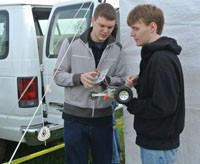
VIDEO: UC Triumphs at the Battle of the Rockets
As part of their senior design project, 20 University of Cincinnati aerospace engineering seniors competed in the American Institute of Aeronautics and Astronautics (AIAA) and Praxis Inc. Battle of the Rockets Competition held on March 31. The 20 seniors were divided into two teams, one of which became the first-place champions!
The contest is an aerospace competition open to universities and high schools, run by a local rocketry society in Culpeper, Va.
Two teams composed of 10 students each, the Rocket Underground and the Chubaccateers, participated in the Planetary Rover Event. In this event, student teams are required to design and create a mars rover, an automated motor vehicle, to be housed in and launched from a rocket. Very few teams participate in this category, likely because of the categorys high complexity.
During the competition, teams launch their rockets, with rovers inside, to a minimum 1,000 feet in altitude. Once launched, each rocket must come apart and deploy its rover. The rover must then be safely transported to the ground via parachute. Once on the ground, teams must design the rover to operate on its own, autonomously, and move a designated distance, make required turns, all while dropping markers.

rover in a can
Each team independently chose its own path in designing an ideal rocket and rover, creating two very impressive systems. The process is complex. Student teams essentially build an aero-system from scratch, programming all necessary movements and applying necessary sensors to meet all competition requirements.
In the process of preparing for the competition, students were exposed to both project management and systems engineering. Assistant Professor Grant Schaffner was the students' advisor throughout the class and competition. The competition allowed for a practical application of the skills rather than in a project setting, describes Schaffner.
In the heat of the competition, each team discovered its rovers werent operating as planned. Quick on their feet, the students worked feverishly to address the programming difficulties.

In weeds
The Chubaccateers rover emitted a bit of smoke, overpowering the current and frying the electronics. The team hastily rushed to a nearby store to buy supplies to completely revamp, reprogram and rewire their electronics in the rover.
Luckily, each team was able to address its problems and make a successful launch. The Chubaccateers truly worked down to the last minute, making their final launch a nail biter. The students successfully launched its rocket and deployed its rover, only to have the rover caught in the evening winds and swept into a nearby field full of overgrown grass.
Unfortunately, the team did not anticipate getting stuck in the weeds, and the rover was hopelessly entangled in the high grass. Had the winds blown differently that day, the Bearcat teams were in place to take home both first and second place

Discussion
The Rocket Underground also faced challenges during test flights. Our biggest challenge in the competition was overcoming a failure we had during our test flight. Our first test launch resulted in a failure after our payload deployed one second after launch due to a programming error. We had to rebuild our engine mount section in one week and modify our body so that we could launch again the next weekend. Our next test launch was 100 percent successful with a dummy weight taking the place of the rover, describes Alex Apyan, Rocket Undergrounds rocket team leader.
With its successful launch and landing, The Rocket Underground won first place and became the Planetary Rover Event Champions!
Apyan credits his teams win to their camaraderie, leadership and preparedness. He reflects, The Battle of the Rockets by itself was a fun experience, but it was really just the visible culmination of all of the work we had put in over the year. During our design classes, we gained a lot of experience in the entire design, manufacturing and operational phases of an engineering system.
Schaffner states, Both teams did extremely well, and I am very proud of them for winning the competition.
Schaffner plans to bring another set of UC students next year to defend their title, along with a new UC Rocketry Club. Schaffner is hopeful that CEAS students will continue to triumph at competitions to come.

teams
Related Stories
OTR mural centerpiece of 'big' celebration of UC alumni
April 26, 2024
New downtown artwork salutes 18 alumni award recipients who personify UC’s alumni success.
UC education allowed couple to make mark on Cincinnati
April 24, 2024
As a native of Defiance, Ohio, John Deatrick, CEAS ’79, says arriving in Cincinnati to attend the University of Cincinnati in 1963 felt like landing in New York City.
Engineering student studying flight physics of birds
April 24, 2024
After earning a bachelor's degree in mechanical engineering in Nepal, Sameer Pokhrel came to the United States to further his education. From an early age, he had a lifelong fascination with aviation. As an adult, he transformed this fascination into a career, pursuing a doctoral degree in aerospace engineering at the University of Cincinnati's historic program. Here, he has succeeded in research, instruction, and was recently named Graduate Student Engineer of the Month by the College of Engineering and Applied Science.
